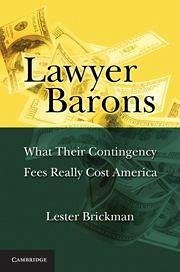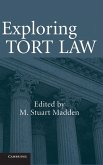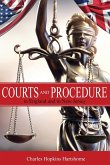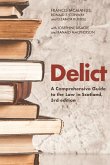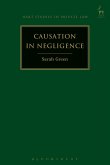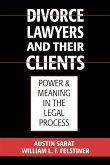Lester Brickman
Lawyer Barons
Lester Brickman
Lawyer Barons
- Gebundenes Buch
- Merkliste
- Auf die Merkliste
- Bewerten Bewerten
- Teilen
- Produkt teilen
- Produkterinnerung
- Produkterinnerung
This book is an inquiry into how contingency fees distort our civil justice system, influence our political system and endanger democratic governance.
Andere Kunden interessierten sich auch für
![A Company's Right to Damages for Non-Pecuniary Loss A Company's Right to Damages for Non-Pecuniary Loss]() Vanessa WilcoxA Company's Right to Damages for Non-Pecuniary Loss106,99 €
Vanessa WilcoxA Company's Right to Damages for Non-Pecuniary Loss106,99 €![Exploring Tort Law Exploring Tort Law]() M. Stuart Madden (ed.)Exploring Tort Law111,99 €
M. Stuart Madden (ed.)Exploring Tort Law111,99 €![Courts and Procedure in England and in New Jersey Courts and Procedure in England and in New Jersey]() Charles Hopkins HartshorneCourts and Procedure in England and in New Jersey23,99 €
Charles Hopkins HartshorneCourts and Procedure in England and in New Jersey23,99 €![Delict Delict]() Francis McmanusDelict226,99 €
Francis McmanusDelict226,99 €![Causation in Negligence Causation in Negligence]() Sarah GreenCausation in Negligence140,99 €
Sarah GreenCausation in Negligence140,99 €![Divorce Lawyers and Their Clients Divorce Lawyers and Their Clients]() Austin SaratDivorce Lawyers and Their Clients67,99 €
Austin SaratDivorce Lawyers and Their Clients67,99 €![Scottish Criminal Evidence Law Scottish Criminal Evidence Law]() Scottish Criminal Evidence Law131,99 €
Scottish Criminal Evidence Law131,99 €-
-
-
This book is an inquiry into how contingency fees distort our civil justice system, influence our political system and endanger democratic governance.
Hinweis: Dieser Artikel kann nur an eine deutsche Lieferadresse ausgeliefert werden.
Hinweis: Dieser Artikel kann nur an eine deutsche Lieferadresse ausgeliefert werden.
Produktdetails
- Produktdetails
- Verlag: Cambridge University Press
- Seitenzahl: 586
- Erscheinungstermin: 24. März 2011
- Englisch
- Abmessung: 235mm x 157mm x 36mm
- Gewicht: 988g
- ISBN-13: 9781107001220
- ISBN-10: 1107001226
- Artikelnr.: 32947369
- Herstellerkennzeichnung
- Libri GmbH
- Europaallee 1
- 36244 Bad Hersfeld
- gpsr@libri.de
- Verlag: Cambridge University Press
- Seitenzahl: 586
- Erscheinungstermin: 24. März 2011
- Englisch
- Abmessung: 235mm x 157mm x 36mm
- Gewicht: 988g
- ISBN-13: 9781107001220
- ISBN-10: 1107001226
- Artikelnr.: 32947369
- Herstellerkennzeichnung
- Libri GmbH
- Europaallee 1
- 36244 Bad Hersfeld
- gpsr@libri.de
Lester Brickman is a Professor of Law and former Acting Dean at the Benjamin N. Cardozo School of Law at Yeshiva University, where he teaches contracts and legal ethics. He has written extensively on legal ethics and his writings have been widely cited in treatises, casebooks, scholarly journals and judicial opinions. Brickman is a leading authority on contingency fees and his writings on that subject are the basis for a proposal to realign the contingency fee system with its policy roots and ethical mandates.
1. The origin of the contingency fee
2. How profitable are contingency fees?
3. Are contingency fee profits 'reasonable'?
4. How tort lawyers have increased their profits by restraining competition
5. Why the market has failed to correct the absence of price competition
6. Impediments imposed by the bar to price competition
7. The effects of incentives created by contingency fees
8. How the quest for profits influenced the development of the tort system
9. Lawyers' role in the expansion of tort liability
10. The role of the judiciary in tort system expansion
11. Current and future expansions of tort liability
12. The litigation explosion: 'fact or fiction'?
13. Measures of the rate of expansion of tort liability
14. The relationship between injury rates and tort system costs
15. The impacts of substantial increases in tort lawyers' effective hourly rates
16. Class actions
17. Fees in class actions
18. How class action lawyers game fee setting
19. Securities class actions
20. Regulation through litigation
21. A new role for punitive damages: policy-making as a profit center
22. For-profit partnerships between state attorneys general and contingency fee lawyers
Appendix A. A critique of Alex Tabarrok, the problem of contingent fees for waiters
Appendix B. Calculating tort lawyers' effective hourly rates in 1960
Appendix C. Electronic discovery and the use of contract lawyers
Appendix D. The HMO litigation
Appendix E. The GM 'side saddle' truck litigation: the (short lived) triumph of litigation over the regulatory process
Appendix F. Modern class actions undermine democratic precepts
Appendix G. Other ways lawyers game class action fees
Appendix H. Non-recourse financing of tort litigation
Appendix I. Political contributions by tort lawyers and the U.S. chamber of commerce
Appendix J. Special rules favoring lawyers
Appendix K. The ultimate medical expense 'build-up': whiplash
Appendix L. The effect of punitive damages on compensatory awards.
2. How profitable are contingency fees?
3. Are contingency fee profits 'reasonable'?
4. How tort lawyers have increased their profits by restraining competition
5. Why the market has failed to correct the absence of price competition
6. Impediments imposed by the bar to price competition
7. The effects of incentives created by contingency fees
8. How the quest for profits influenced the development of the tort system
9. Lawyers' role in the expansion of tort liability
10. The role of the judiciary in tort system expansion
11. Current and future expansions of tort liability
12. The litigation explosion: 'fact or fiction'?
13. Measures of the rate of expansion of tort liability
14. The relationship between injury rates and tort system costs
15. The impacts of substantial increases in tort lawyers' effective hourly rates
16. Class actions
17. Fees in class actions
18. How class action lawyers game fee setting
19. Securities class actions
20. Regulation through litigation
21. A new role for punitive damages: policy-making as a profit center
22. For-profit partnerships between state attorneys general and contingency fee lawyers
Appendix A. A critique of Alex Tabarrok, the problem of contingent fees for waiters
Appendix B. Calculating tort lawyers' effective hourly rates in 1960
Appendix C. Electronic discovery and the use of contract lawyers
Appendix D. The HMO litigation
Appendix E. The GM 'side saddle' truck litigation: the (short lived) triumph of litigation over the regulatory process
Appendix F. Modern class actions undermine democratic precepts
Appendix G. Other ways lawyers game class action fees
Appendix H. Non-recourse financing of tort litigation
Appendix I. Political contributions by tort lawyers and the U.S. chamber of commerce
Appendix J. Special rules favoring lawyers
Appendix K. The ultimate medical expense 'build-up': whiplash
Appendix L. The effect of punitive damages on compensatory awards.
1. The origin of the contingency fee
2. How profitable are contingency fees?
3. Are contingency fee profits 'reasonable'?
4. How tort lawyers have increased their profits by restraining competition
5. Why the market has failed to correct the absence of price competition
6. Impediments imposed by the bar to price competition
7. The effects of incentives created by contingency fees
8. How the quest for profits influenced the development of the tort system
9. Lawyers' role in the expansion of tort liability
10. The role of the judiciary in tort system expansion
11. Current and future expansions of tort liability
12. The litigation explosion: 'fact or fiction'?
13. Measures of the rate of expansion of tort liability
14. The relationship between injury rates and tort system costs
15. The impacts of substantial increases in tort lawyers' effective hourly rates
16. Class actions
17. Fees in class actions
18. How class action lawyers game fee setting
19. Securities class actions
20. Regulation through litigation
21. A new role for punitive damages: policy-making as a profit center
22. For-profit partnerships between state attorneys general and contingency fee lawyers
Appendix A. A critique of Alex Tabarrok, the problem of contingent fees for waiters
Appendix B. Calculating tort lawyers' effective hourly rates in 1960
Appendix C. Electronic discovery and the use of contract lawyers
Appendix D. The HMO litigation
Appendix E. The GM 'side saddle' truck litigation: the (short lived) triumph of litigation over the regulatory process
Appendix F. Modern class actions undermine democratic precepts
Appendix G. Other ways lawyers game class action fees
Appendix H. Non-recourse financing of tort litigation
Appendix I. Political contributions by tort lawyers and the U.S. chamber of commerce
Appendix J. Special rules favoring lawyers
Appendix K. The ultimate medical expense 'build-up': whiplash
Appendix L. The effect of punitive damages on compensatory awards.
2. How profitable are contingency fees?
3. Are contingency fee profits 'reasonable'?
4. How tort lawyers have increased their profits by restraining competition
5. Why the market has failed to correct the absence of price competition
6. Impediments imposed by the bar to price competition
7. The effects of incentives created by contingency fees
8. How the quest for profits influenced the development of the tort system
9. Lawyers' role in the expansion of tort liability
10. The role of the judiciary in tort system expansion
11. Current and future expansions of tort liability
12. The litigation explosion: 'fact or fiction'?
13. Measures of the rate of expansion of tort liability
14. The relationship between injury rates and tort system costs
15. The impacts of substantial increases in tort lawyers' effective hourly rates
16. Class actions
17. Fees in class actions
18. How class action lawyers game fee setting
19. Securities class actions
20. Regulation through litigation
21. A new role for punitive damages: policy-making as a profit center
22. For-profit partnerships between state attorneys general and contingency fee lawyers
Appendix A. A critique of Alex Tabarrok, the problem of contingent fees for waiters
Appendix B. Calculating tort lawyers' effective hourly rates in 1960
Appendix C. Electronic discovery and the use of contract lawyers
Appendix D. The HMO litigation
Appendix E. The GM 'side saddle' truck litigation: the (short lived) triumph of litigation over the regulatory process
Appendix F. Modern class actions undermine democratic precepts
Appendix G. Other ways lawyers game class action fees
Appendix H. Non-recourse financing of tort litigation
Appendix I. Political contributions by tort lawyers and the U.S. chamber of commerce
Appendix J. Special rules favoring lawyers
Appendix K. The ultimate medical expense 'build-up': whiplash
Appendix L. The effect of punitive damages on compensatory awards.

